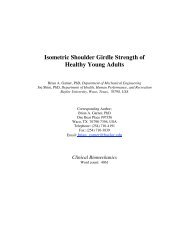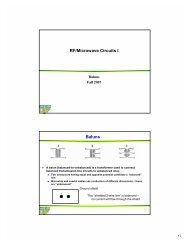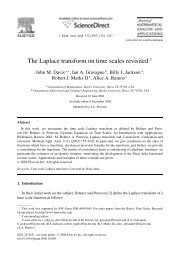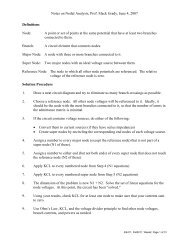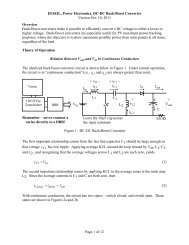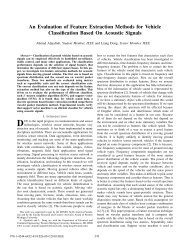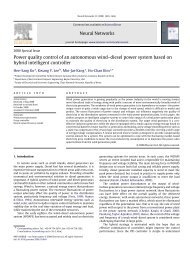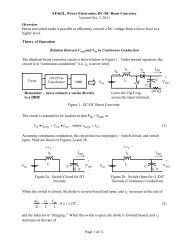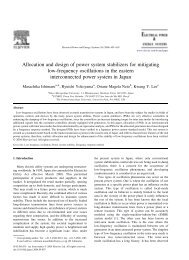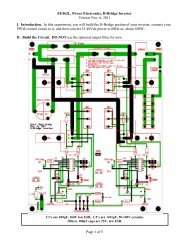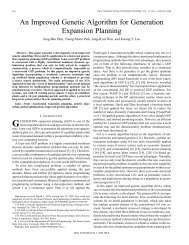A Self-Organizing Power System Stabilizer using ... - IEEE Xplore
A Self-Organizing Power System Stabilizer using ... - IEEE Xplore
A Self-Organizing Power System Stabilizer using ... - IEEE Xplore
You also want an ePaper? Increase the reach of your titles
YUMPU automatically turns print PDFs into web optimized ePapers that Google loves.
443<br />
generated rules are stored in the fuzzy rule space and updated<br />
on-line by a self-organizing procedure.<br />
Characteristics of the FARh4A FLC algorithm are discussed<br />
in this paper from the point of view of its applicability to<br />
PSS. A modified form of FARMA FLC which is more<br />
suitable for PSS is developed and presented.<br />
11. BRIEF REVIEW OF FARMA FLC [ 131<br />
A. DeJinition of the FARMA Rule<br />
In general, the output of a system can be described with a<br />
function or a mapping of the plant input-output history. For a<br />
single-input single-output (SISO) discrete-time system, the<br />
mapping can be written in the form of a nonlinear autoregresisive<br />
moving average (NARMA) as follows:<br />
where y(k) and u(k) are respectively the output and input<br />
variables at the k-th time step.<br />
The objective of the control problem is to find a control<br />
input sequence which will drive the system to an arbitrary<br />
reference set point yIeF Rearranging (1) for control purpose,<br />
the value of the input U at the k-th step that is required to yield<br />
the reference output yref can be written as follows:<br />
which is viewed as an inverse mapping of (1).<br />
The proposed controller doesn't use rules pre-constructed by<br />
experts, but forms rules with input and output history at every<br />
sampling step. The rules generated at every sampling step are<br />
stored in a rule base, and updated as experience is<br />
accumulated <strong>using</strong> a self-organizing procedure.<br />
The system (1) yields the last output value y(k+l) when the<br />
output and input values, y(k), y(k- l), y(k-2), ..*, u(k), u(k- I),<br />
u(k-2), ..., are given. This implies that u(k) is the input to be<br />
applied when the desired output is yref as indicated explicitly<br />
in (2). Therefore, a FARMA rule with the input and output<br />
history is defined as follows:<br />
IFYrefis Ali, y(k) is A2i, y(k-1) is A3i, ..., y(k-n+l) is A(,+iy<br />
AND u(k-I) is Bli, ~(k-2) is B2i ,..., u(k-m) is B,i,<br />
THEN u(k) is Ci, (for the i-th rule) (3)<br />
where, n, m : number of output and input variables<br />
Aij, Bij : antecedent linguistic values for the i-th rule<br />
Ci : consequent linguistic value for the i-th rule.<br />
The rule (3) is generated at (k+l) time step. Therefore, y(k+l)<br />
is given value at &+I) step. The rule (3) explaines that " If<br />
desired yref is y(k+l) with given input-output history, y(k),<br />
y(k-l), y(k-2), -., u(k), u(k-I), u(k-2), -.., THEN u(k) is the<br />
input to be applied".<br />
In a conventional FLC, an expert usually determines the<br />
linguistic values Ai+ Bij, and Ci by partitioning each universe<br />
of discourse, and the formulation of fuzzy logic control rules<br />
is achieved on the basis of the expert's experience and<br />
knowledge. In this paper, however, these linguistic values are<br />
determined from the crisp values of the input and output<br />
history at every sampling step. Therefore, at the initial stage,<br />
the assigned u(k) may not be a good control, but over time,<br />
the rule base is updated <strong>using</strong> the self-organizing procedure,<br />
and better controls are applied.<br />
A fuzzification procedure for fuzzy values of (3) is<br />
developed to determine A,,, -., A(,+,),, Bli, B2i , ..., Bmi,<br />
and Ci from the crisp y(k+ l), y(k), y(k-1), -a,<br />
y(k-n+l), u(k-<br />
I), u(k-2), ..., u(k-m), and u(k), respectively. The fuzzification<br />
is done with its base on a reasonably assumed input or output<br />
ranges. When the assumed input or output range is [a, b], the<br />
membership function for crisp x1 is determined in a triangular<br />
shape as follows:<br />
l o else<br />
l+(x-xl)/(b-a) if alx



